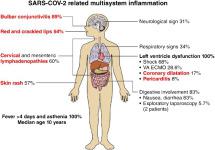Archives of Cardiovascular Diseases ( IF 2.3 ) Pub Date : 2021-05-24 , DOI: 10.1016/j.acvd.2021.04.005 Jean-Christophe Mercier 1 , Naim Ouldali 2 , Isabelle Melki 3 , Romain Basmaci 4 , Michael Levy 5 , Luigi Titomanlio 6 , Constance Beyler 7 , Ulrich Meinzer 8

|
The severe acute respiratory syndrome coronavirus 2 (SARS-CoV-2) pandemic has been characterized by high transmission rates and high mortality in adults with predisposing factors, including age > 70 years, obesity, diabetes, systemic hypertension and other underlying diseases. During the second week of viral pneumonia, acute respiratory distress syndrome can occur and carries high mortality. Unlike most common respiratory viruses, children seem to be less susceptible to SARS-CoV-2 infection, and generally develop mild disease with low mortality. However, clusters of severe shock associated with high levels of cardiac biomarkers and unusual vasoplegia requiring inotropes, vasopressors and volume loading have recently been described. Both the clinical symptoms (i.e. high and persistent fever, gastrointestinal disorders, skin rash, conjunctival injection and dry cracked lips) and the biological signs (e.g. elevated C-reactive protein/procalcitonin and high levels of ferritinaemia) mimicked Kawasaki disease. In most cases, intravenous immunoglobin therapy improved cardiac function and led to full recovery within a few days. Adjunctive steroid therapy and sometimes biotherapy (e.g. anti-interleukin 1Ra and anti-interleukin 6 monoclonal antibodies) were often necessary. Although almost all children fully recovered within a week, some of them later developed coronary artery dilation or aneurysm. Thus, a new “multisystem inflammatory syndrome in children” related to SARS-CoV-2 has recently been described. Similarities with Kawasaki disease and the physiopathology of this syndrome still need further exploration.
中文翻译:

模仿川崎病的儿童严重急性呼吸系统综合症冠状病毒 2 相关多系统炎症综合症
严重急性呼吸系统综合症冠状病毒 2 (SARS-CoV-2) 大流行的特点是在具有诱发因素的成年人中具有高传播率和高死亡率,包括年龄 > 70年代,肥胖、糖尿病、高血压等基础疾病。在病毒性肺炎的第二周,可出现急性呼吸窘迫综合征,死亡率很高。与大多数常见的呼吸道病毒不同,儿童似乎不太容易感染 SARS-CoV-2,并且通常病情较轻,死亡率较低。然而,最近描述了与高水平心脏生物标志物和异常血管麻痹相关的严重休克群,需要正性肌力药、升压药和容量负荷。临床症状(即持续高烧、胃肠道疾病、皮疹、结膜充血和嘴唇干裂)和生物学体征(例如 C 反应蛋白/降钙素原升高和铁蛋白血症水平升高)均与川崎病相似。在多数情况下,静脉注射免疫球蛋白治疗改善了心脏功能,并在几天内完全康复。辅助类固醇治疗和有时生物治疗(例如抗白细胞介素 1Ra 和抗白细胞介素 6 单克隆抗体)通常是必需的。虽然几乎所有的孩子都在一周内完全康复,但其中一些后来出现了冠状动脉扩张或动脉瘤。因此,最近描述了一种与 SARS-CoV-2 相关的新的“儿童多系统炎症综合征”。与川崎病的相似性和该综合征的病理生理学仍有待进一步探索。虽然几乎所有的孩子都在一周内完全康复,但其中一些后来出现了冠状动脉扩张或动脉瘤。因此,最近描述了一种与 SARS-CoV-2 相关的新的“儿童多系统炎症综合征”。与川崎病的相似性和该综合征的病理生理学仍有待进一步探索。虽然几乎所有的孩子都在一周内完全康复,但其中一些后来出现了冠状动脉扩张或动脉瘤。因此,最近描述了一种与 SARS-CoV-2 相关的新的“儿童多系统炎症综合征”。与川崎病的相似性和该综合征的病理生理学仍有待进一步探索。











































 京公网安备 11010802027423号
京公网安备 11010802027423号